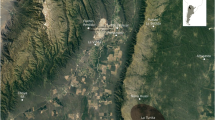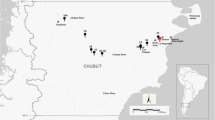Abstract
The present paper reports the chemical and mineralogical composition of a black pigment material contained in a Syrian Bottle-shaped vessel excavated on an Early Bronze Age grave in Müslümantepe, a site located at the right bank of the Tigris River in Southeastern Anatolia. A combination of different analytical tools like state-of-the-art non-destructive μ-XRD2, μ-XRF and μ-Raman spectroscopy compared to classical powder XRD was used to characterize the content of the bottle. The results attest the presence of a manganese mineral (pyrolusite) most probably used for cosmetic purposes. This is the first evidence, which is scientifically tested, of the earliest use of cosmetics in the Upper Tigris of Southeastern Anatolia during the Early Bronze Age period, c. 2700–2550 bc.





Similar content being viewed by others
References
Arcane Cultural Horizon Table, v.5.4.4. http://www.arcane.uni-tuebingen.de/EA-EM-EL_phasing_v5-4-6.pdf. Accessed 30 Oct 2013
Berthold C, Bjeoumikhov A, Brügemann L (2009) Fast XRD2 microdiffraction with focusing X-ray microlenses. Part Part Syst Charact 26(3):107–111
Emre K (1999) Syrian bottles from Karum of Kanish. In: Mikasa MT (ed) Essays on ancient Anatolia. Bulletin of the Middle Eastern Culture Center in Japan XI. Harrassowitz, Wiesbaden
Erkanal H (1991) 1989 Girnavaz Kazıları, XII. Kazı Sonuçları Toplantısı I, Ankara
Freestone IC, Meeks ND, Middleton P (1985) Retention of phosphate in buried ceramics: an electron microbeam approach. Archaeometry 27(2):161–177
Hauptmann H (1982) Lidar Höyük 1981. Türk Arkeoloji Dergisi 261:93–110
Honça MD, Algaze G (1998) Preliminary report on the human skeletal remains at Titriş Höyük 1991–1996 seasons. Anatolica 24:101–143
Matney T, Algaze G, Pittman H (1997) Excavations at Titriş Höyük in Southeastern Turkey: a preliminary report of the 1996 season. Anatolica 23:61–85
Martinetto P, Anne M, Dooryhée E, Tsoucaris G, Walter P (2000) Synchrotron X-ray diffraction study of Egyptian cosmetics. In: Creagh DC, Bradley DA (eds) Radiation in art and archaeometry. Elsevier Science, Amsterdam, pp 297–316
Moorey PRS (1994) Ancient Mesopotamian materials and industries: the archaeological evidence. Clarendon Press, Oxford
Ökse AT (2004) Gre Virike Kazıları. I.- II. Ulusal Arkeoloji Araştırmalerı Sempozyumu. Anadolu/Anatolia Ek Dizi 1:157–166
Ökse AT (2005) Early Bronze Age chamber complexes at Gre Virike Period IIA on the Middle Euphrates. Bull Am Sch Orient Res 339:21–46
Ökse AT (2006) Gre Virike (period I)—Early Bonze Age ritual facilities on the Middle Euphrates River. Anatolica 32:1–27
Ökse AT (2011) The early bronze age in Southeastern Anatolia. In: Steadman SR, McMahon G (eds) The Oxford handbook of ancient Anatolia. Oxford University Press, New York, pp 260–289
Özgen E (1989–1990) Oylum Höyük a brief account of investigations conducted in 1987–1989. Anatolica 16:21–29
Özgen E, Helwing B (2003) On the shifting border between Mesopotamia and the west: seven seasons of joint Turkish-Germen excavations at Oylum Höyük. Anatolia 29:61–87
Pruß A (2001) Die Graue Ğazīra-Ware. In: Waalke-Meyer J, Novák M, Pruß A (eds) Beiträge zur Vorderasiatischen Archäologie. Wilfried Orthmann gewidmet, Frankfurt, pp 412–429
Rahmstorf L (2006) Zur Ausbreitung vorderasiatischer Innovationen in die frühbronzezeitliche Ägäis. Praehistorische Zeitschrift 81(1):1–134
Rhea K, Nejat N (1998) Daily life in ancient Mesopotamia. Greenwood Press, Westport
Roodenberg JJ (1979–1980) Premiers Resultats des Recherches Archeologigues a Hayaz Höyük. Anatolica 7:3–21
Sang L (2010) Burial practices of the third millennium BCE in the Middle Euphrates Region: an interpretation of funerary rituals. (Unpublished PhD. Thesis) Tübingen. Available at http://tobias-lib.uni-tuebingen.de/volltexte/2010/5000/
Yılmaz D (2006) Burial customs of chamber tombs in Southeast Anatolia during the Early Bronze Age. Anadolu/Anatolia 31:71–90
Zimmermann T (2005) Perfumes and policies—a ‘Syrian Bottle’ from Kinet Höyük and Anatolian trade patterns in the advanced third millennium BC. Anatolica 31:161–169
Acknowledgments
We would like to express our appreciation to Nevin Soyukaya, Director of the archaeological museum of Diyarbakir for access to the sample of this study and Melanie Keuper, University of Tübingen, for the measurement and kindly sharing her expertise in Raman spectroscopy. We also thank the anonymous referees for their valuable comments and suggestions.
Author information
Authors and Affiliations
Corresponding author
Rights and permissions
About this article
Cite this article
Ay, E., Kibaroğlu, M. & Berthold, C. A multi-analytical approach to characterize an Early Bronze Age cosmetic material from Müslümantepe, Southeastern Anatolia. Archaeol Anthropol Sci 6, 125–131 (2014). https://doi.org/10.1007/s12520-013-0166-z
Received:
Accepted:
Published:
Issue Date:
DOI: https://doi.org/10.1007/s12520-013-0166-z




